Annual Open Letter to the People of Purdue from Mitch Daniels
January 2017
I enjoyed the great good fortune of knowing Gen. Jimmy Doolittle, pioneer aviator and war hero, during the last few years of his life. The general is best remembered for conceiving and pulling off the impossibly audacious air raid of Tokyo just months after Pearl Harbor, lifting American morale and signaling to the Japanese that they had chosen the wrong foe for their sneak attack.
But long before his World War II exploits, Jimmy Doolittle was perhaps the nation’s most innovative developer of the young field of manned flight. A serious scholar as well as a brave pilot, he studied at MIT between the wars. He became the first pilot to fly blind, by instruments alone, and developed the concept of high-octane fuel. He led the growth of aviation technology through both thought and deed; he would have made a perfect Boilermaker.
The general has been on my mind lately because of the nickname he acquired during his storied career. He was called “the master of the calculated risk." Although he took chances, often life-threatening ones, they were never merely reckless or exhibitionist. Rather, his innovations were always preceded by careful analysis that, in his considered judgment, justified the risks he undertook, in pursuit of the breakthroughs and progress he envisioned.
As 2017 opens at Purdue, we face a number of decisions that, while trivial compared to the mortal dangers Doolittle confronted, involve substantial risk of either misjudgment or outright failure. In each case, we have tried to think over the options carefully, and examined the risks of inaction alongside the odds of success. Several of the items in this year’s letter fall into this category of “calculated risk”; its readers are invited to make their own calculations.
Not so long ago, there was essentially zero risk in public higher education. Dollars flowed in steadily growing amounts from state treasuries, and were augmented by an apparently limitless ability to raise tuition and fees every year. No one questioned the value of a college diploma, nor whether too many young people were pursuing one.
That’s all over. During 2016, the skeptical trends of recent years intensified. Almost half of Americans now doubt that a higher education is a good investment, and nearly 60% say a college education is no longer necessary to a person’s success.[i] Escalating costs are the main driver of these concerns: 75 to 90% of freshmen nationally say that cost was a major factor in their college choice, and one-quarter to one-third said they could not afford their first choice.[ii] 44% of U.S. citizens label colleges “wasteful and inefficient.”[iii]
Total attendance at public colleges fell again, by 1%. At the University of Missouri, with campus disruption playing a part, the drop was a calamitous 25% in entering freshmen.[iv]
Meanwhile, alternatives to the traditional higher ed model continued to expand. Massive open online course enrollments, better known as MOOCs, increased from 35 million to 58 million this past year.[v] Virtual certificates and badges are now being accepted as credentials at a growing number of companies. Corporations like UPS and GE now offer employees thousands of internally taught courses outside of traditional higher education. Predictions persist of a sectoral disruption akin to that which hit the newspaper, photography, department store, record and bookstore businesses and others. One particularly pungent critique forecast that residential colleges would become “the debutante cotillion of the 21st Century,” a quaint artifact of enduring attraction only to a cloistered, almost irrelevant few.
At Purdue, we do not discount these alarming possibilities, but we do not accept their inevitability. We view the current challenges to higher ed as real and the criticisms as in many cases legitimate. We believe that a posture of denial, obstinately insisting on the superiority of the model just as it is, would be both irresponsible and dangerous.
But neither do we accept that the residential university experience is destined for the creative destruction boneyard. Modernized and enhanced, we believe strongly that Purdue and its sister schools can still offer a compelling case to ambitious and talented young people decades from now. That case must be built around provable, unquestionable value that cannot be replicated in even the most advanced alternative modes.
The rest of this letter summarizes a few of the actions Purdue is taking to deliver these new dimensions of value. Most do involve an element of uncertainty; we must hope that, like Gen. Doolittle, we have calculated the risks wisely and can carry out our ideas skillfully.
Academic rigor and integrity
Scholars and employers alike have detected a steady weakening of academic rigor over recent decades. Today’s college students report an average weekly work load only half that reported in the 1960s.[vi] A proliferation of narrow “micro” courses of little apparent difficulty or usefulness, with titles like “Tree Climbing,” “Witchcraft and Possession,” “Ice Cream 101,” and “Lawn Boy Meets Valley Girl” (none of these are Purdue examples!) often leads to understandable mockery.
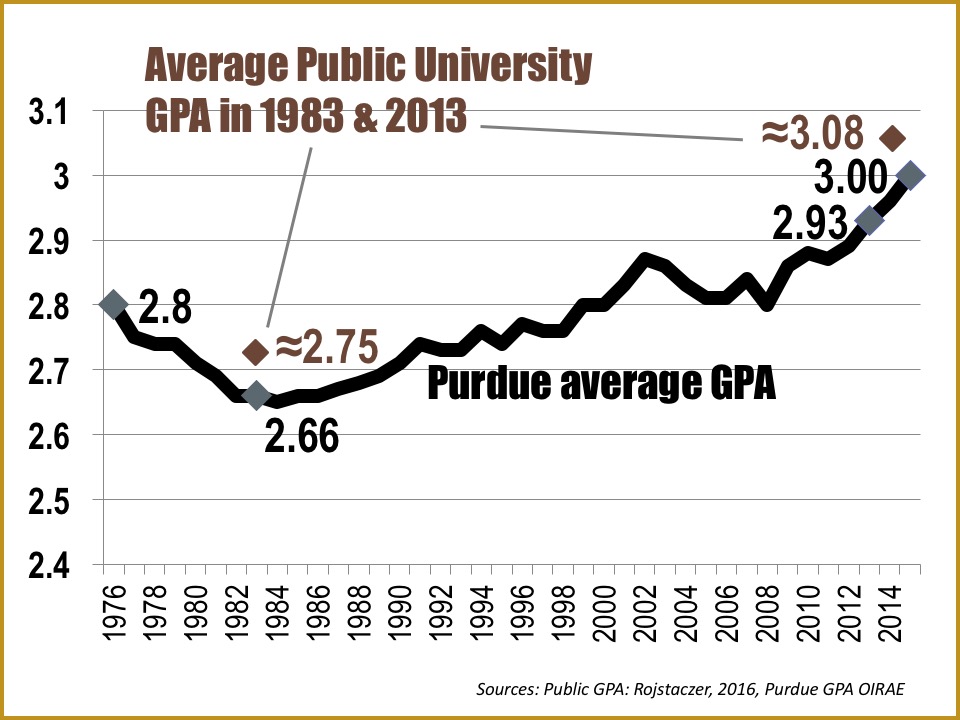
Maybe most concerning, average grades across U.S. institutions have climbed to levels where it is impossible to tell which students are truly outstanding or well prepared. The average term GPA at many private universities such as Vassar and Swarthmore is approaching 3.60. At public schools like the University of Michigan and the University of Virginia it is around 3.35.[vii] And exacerbating the situation is clear evidence that many of the grades being received were not earned fairly, but were the product of cheating: according to the international center for academic integrity, some 68% of undergraduates nationwide admit to cheating on tests or writing assignments.[viii]
From the trend of declining rigor, Purdue has historically stood apart. The average GPA among our students continues to run substantially below all national and peer averages. Still, our average has risen considerably over the last couple decades.
Much, but it is not clear all, of the increase is directly attributable to the ever-higher caliber of our entering students and the impact of recent investments in student success initiatives.
Not infrequently, students express to me the fear that they will suffer competitively when seeking jobs vs. students who attended more lenient schools. Acknowledging this possibility, we still hold that a relatively tough curriculum, with tough assessment standards, serves both our students and their eventual employers well. Our job placement rates (2% unemployment for last year’s graduates), and consistent anecdotal testimony from companies recruiting on our campus, fortifies this conviction. The performance of Purdue students on licensing exams offers more proof, with Purdue passage rates beating the national rate on 11 out of 11 of the nation’s most significant exams.
Our faculty, under the auspices of the University Senate, has undertaken a look at the status of rigor at Purdue. They are considering three questions: 1) Is a Purdue degree truly harder to earn than degrees at most other schools? 2) If so, do we believe that is a desirable situation and goal? 3) If so, what can be done across a university of ten colleges and more than 2,000 faculty to maintain that rigor?
Simultaneously, another Senate inquiry is looking into the state of academic integrity on our campus. I am pleased to report that our students, including our student government leadership, have shown an interest in this same subject and are adding their insights and suggestions.
The widespread perception that many college diplomas have been cheapened is one reason for the disturbingly negative attitudes now directed at our sector. Any risks a policy of greater rigor may entail seem well worth running to preserve the high credibility of a Purdue education.
| National Pass Rate | Purdue Pass Rate | |
|---|---|---|
| All Major National Exams | 84% | 96% |
| Speech, Language Pathology | 85% | 100% |
| Registered Nurse | 86% | 95% |
| Doctor of Audiology | 70% | 100% |
| Fundamentals of Engineering | 76% | 95.1% |
| # of exams Purdue beat the national pass rate: 11 of 11 | ||
On-campus living
This fall, boosted by our biggest freshman class in many years, a near-record number of students arrived at West Lafayette. Moreover, what is likely a record percentage of those more than 30,000 students are residing within our campus boundaries. This is very much by design.
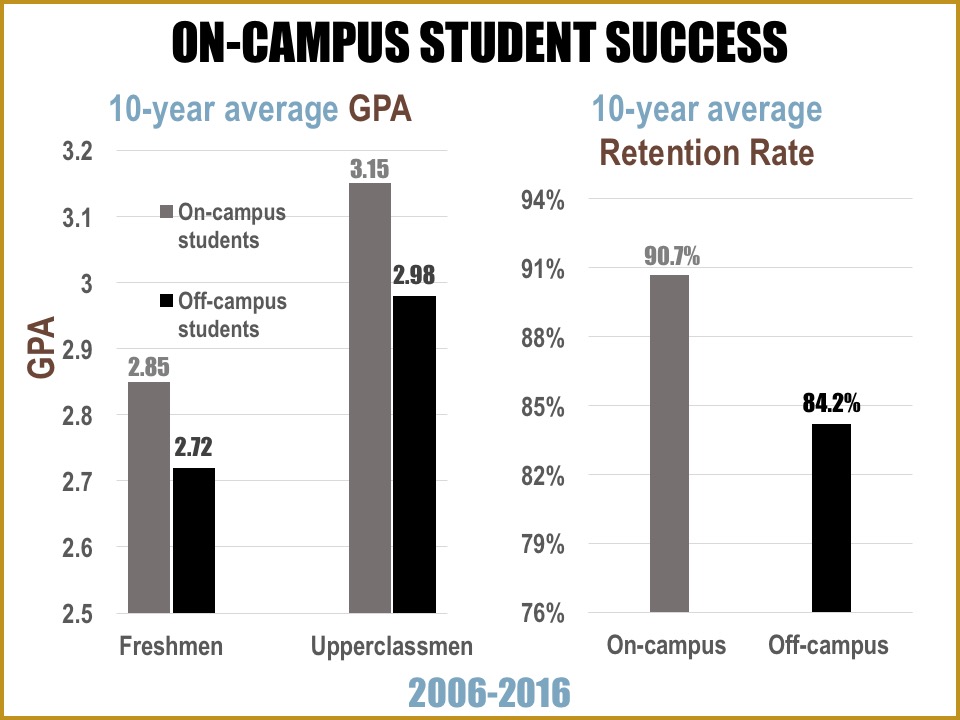 At a time when so many voices and options are inviting young people to find alternatives to the traditional residential experience, we recognize the risks of creating more university-sponsored housing. We have chosen to accept that risk for one overriding reason: the evidence that students who live on campus are more likely to succeed academically than those who do not.
At a time when so many voices and options are inviting young people to find alternatives to the traditional residential experience, we recognize the risks of creating more university-sponsored housing. We have chosen to accept that risk for one overriding reason: the evidence that students who live on campus are more likely to succeed academically than those who do not.
Therefore we have opened our 800-bed Honors College and the 300-bed Third Street Suites. Substantial new housing, including replacement housing aimed at graduate students along State Street, is in the offing. Including co-op and Greek organizations, we already have more than half our undergrads living within the campus perimeter, with the goal of raising that percentage measurably over the next few years.
We have no intentions of entering the “amenities arms race” by building country club-like facilities. Our designs for new or retrofitted housing emphasize “academicizing” features such as study areas and faculty accommodations. Already, one-third of our freshmen opt for “learning communities” where an entire floor or living area is filled with students from the same college or discipline, who can support each other and for whom additional educational programming can be provided.
If in fact online education supplants some or even all of the traditional four-year, on-campus norm, these investments may look very foolish years from now. But we believe that well-conceived living arrangements can add intellectual growth possibilities that will be hard for even the most dazzling future technology to deliver in a student’s basement at home.
State Street
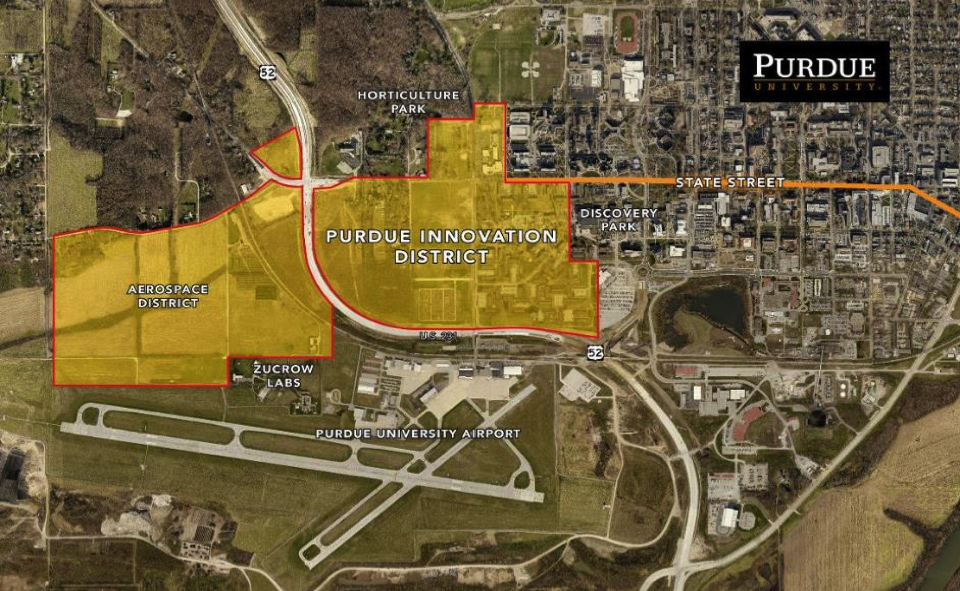 We are placing another bet on the continued viability of the residential model in our joint venture with the City of West Lafayette to transform the State Street corridor, and to create one of the nation’s first university-based “innovation districts.” The narrowing and beautification of State Street, all the way from our new “front door” on the 231 bypass on the west to the Wabash River on the east, can bring our campus together and into a new closeness with our host community.
We are placing another bet on the continued viability of the residential model in our joint venture with the City of West Lafayette to transform the State Street corridor, and to create one of the nation’s first university-based “innovation districts.” The narrowing and beautification of State Street, all the way from our new “front door” on the 231 bypass on the west to the Wabash River on the east, can bring our campus together and into a new closeness with our host community.
The innovation district concept contemplates a large area of residential, commercial, and recreational spaces, adjacent to the research, cultural, and human resources assets of a top-tier research university like ours. If it works, it will attract new business investment similar in scale and sophistication to the area’s new GE jet engine plant. One day the land near and around our airport could be home to exciting businesses working with our researchers and employing our graduates, many of whom might be living within a walk or bike ride from their place of work.
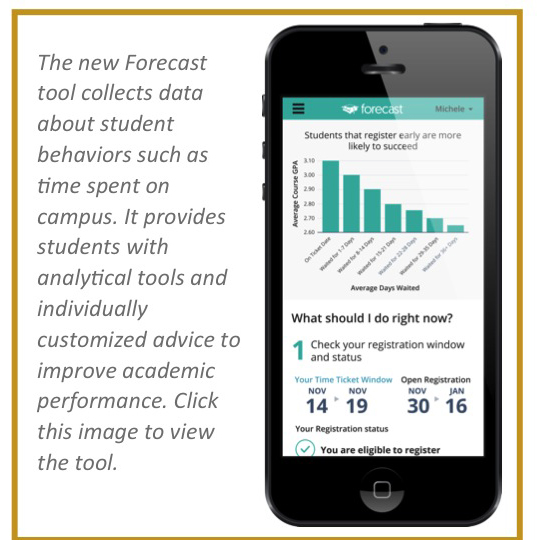 Of course, that’s the upside. Like other of our initiatives, there is also the chance that an evolution (or revolution) away from the higher ed we have known could render the concept obsolete before it takes shape. But if we seek to recruit the finest faculty, and the finest students in the world to West Lafayette, then aggressive action to develop the most attractive possible living environment seems like a risk reasonably well-calculated.
Of course, that’s the upside. Like other of our initiatives, there is also the chance that an evolution (or revolution) away from the higher ed we have known could render the concept obsolete before it takes shape. But if we seek to recruit the finest faculty, and the finest students in the world to West Lafayette, then aggressive action to develop the most attractive possible living environment seems like a risk reasonably well-calculated.
Value beyond the classroom
As I wrote in last year’s letter, Purdue has exchanged any “weed ’em out” mentality for a “help ’em out” commitment to the success of every student we admit. To that end, we continue to expand our tutoring and supplemental instruction offerings, and are building applications that notify individual students of opportunities for help, and of potential challenges in their course selections or study habits.
Our faculty and trustees took steps this year to enhance the Purdue academic experience. Taking note of data from a host of studies including our own Gallup-Purdue Index, they added incentives to incorporate personal mentoring and undergraduate research into the university’s tenure and promotion policy. Along with relevant internships, these activities strengthen the performance and career readiness of graduates, and we intend to be a leader in making them a part of every Boilermaker’s time at Purdue. The investments involved are not insignificant, but again we see the prospect of adding value hard to replicate in some virtual or remote fashion.
Controlling the denominator
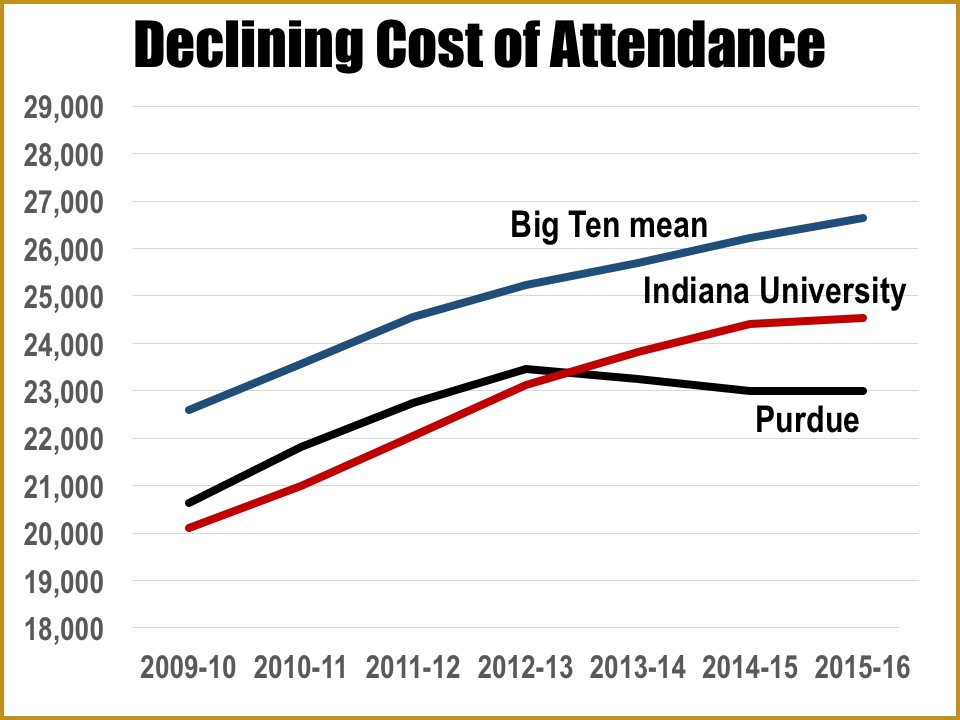 However great the academic value we deliver, half of life’s fundamental value calculations always involve cost. By now, Purdue’s commitment to control as best we can the cost we charge for our educational product is pretty well established. This coming fall, we will enter our fifth consecutive year without a tuition increase on any student while room and board rates, which have been reduced from four years ago, will also stay flat. As a result of such decisions, Purdue is the only research university in the country that is less expensive to attend today than in the fall of 2012.
However great the academic value we deliver, half of life’s fundamental value calculations always involve cost. By now, Purdue’s commitment to control as best we can the cost we charge for our educational product is pretty well established. This coming fall, we will enter our fifth consecutive year without a tuition increase on any student while room and board rates, which have been reduced from four years ago, will also stay flat. As a result of such decisions, Purdue is the only research university in the country that is less expensive to attend today than in the fall of 2012.
This policy, too, carried with it an element of risk, or so we were told at its inception, which followed 36 straight years of increases. There were those who feared financial problems without the annual price hike. More intriguing was the argument that restraint in our student charges would signal a lack of quality, and might injure our marketplace reputation.
Happily, neither of these concerns has proven valid. Fiscally, our university is more solid than it already was, with ample funds in reserve should setbacks occur. We have added to our faculty, which is larger than it has ever been, and we have not done so “on the cheap”; in fact, we are at the top end of American universities in our ratio of tenured/tenure-track to contingent faculty. Our pay raises have been highly competitive against all peer groups.
| Public University | Instructors that are Tenured or Tenure Track | Rank |
|---|---|---|
| Nebraska | 76% | 1 |
| Georgia Tech | 75% | 2 |
| Purdue | 75% | 3 |
| UC Santa Barbara | 73% | 4 |
| Iowa State | 71% | 5 |
| Illinois | 71% | 6 |
| Florida | 69% | 7 |
| Washington | 64% | 8 |
| Arizona | 64% | 9 |
| North Carolina | 62% | 10 |
| FY 2014-16 Change | ||
|---|---|---|
| Tenure & Tenure Track | + 83 | |
| Lecturers | + 42 | |
| Research, Clinical, Post Doc | + 110 | |
| Adjunct | - 15 | |
| Change | % Change | |
| Total Faculty Increase | 220 | 6.97% |
As for our “brand,” the last few years have brought consecutive records in applications, reaching 48,000 for this year’s freshman class. That demand level produced, as noted, the largest class in many years, while our student success programs are keeping more of our current Boilermakers with us and contributing tuition for another year.
In the newly hazardous environment described above, we take nothing for granted, and each year’s tuition/fees decisions are among the most important and sensitive that our trustees make. But more than finances are at stake here.
We never forget Purdue’s land-grant mission, as noble and real today as it was at our creation a century and a half ago. We exist to spread the benefits of higher education to all young people, of all income levels, who have the ability and the work ethic to meet our standards and fulfill our requirements. We are gratified that our cost-control policy has worked well from an operational standpoint. But it is our objective to remain accessible to all that motivates us in this endeavor, and while we obviously cannot continue our tuition freeze indefinitely, affordability will remain our guiding principle. Which brings me to one final risk, probably the largest of those we have chosen to run currently.
Purdue Polytechnic High School
We cannot be the university we aspire to be unless we enroll each year a genuine cross-section of Indiana young people, and give them the first-class preparation for life a Purdue education so provably provides. Regrettably, too many Hoosier school systems are not producing nearly enough Purdue-ready graduates. The shortfalls are especially grievous among first-generation, low-income, and minority students.
In all recent years, the total number of Indiana African-American high school graduates with GPAs and standardized test scores at even the mean of Purdue freshmen has ranged around 100. In the state’s largest school district, the Indianapolis Public Schools, the total number of students of all backgrounds Purdue was able to admit for the class of 2020 was 26 of whom 12 accepted. We simply cannot wait on the K-12 system to improve its results dramatically enough to rectify this intolerable situation.
As you may have heard, we have decided to attempt direct action, by establishing a Purdue-sponsored charter high school in inner-city Indianapolis. The Purdue Polytechnic High School will be patterned after our highly innovative new Polytechnic Institute at West Lafayette, the redesigned and renamed College of Technology. At the high school, students will find a STEM-based curriculum, team-taught and very “hands on,” featuring industry-sponsored projects and emphasizing the development of problem-solving skills.
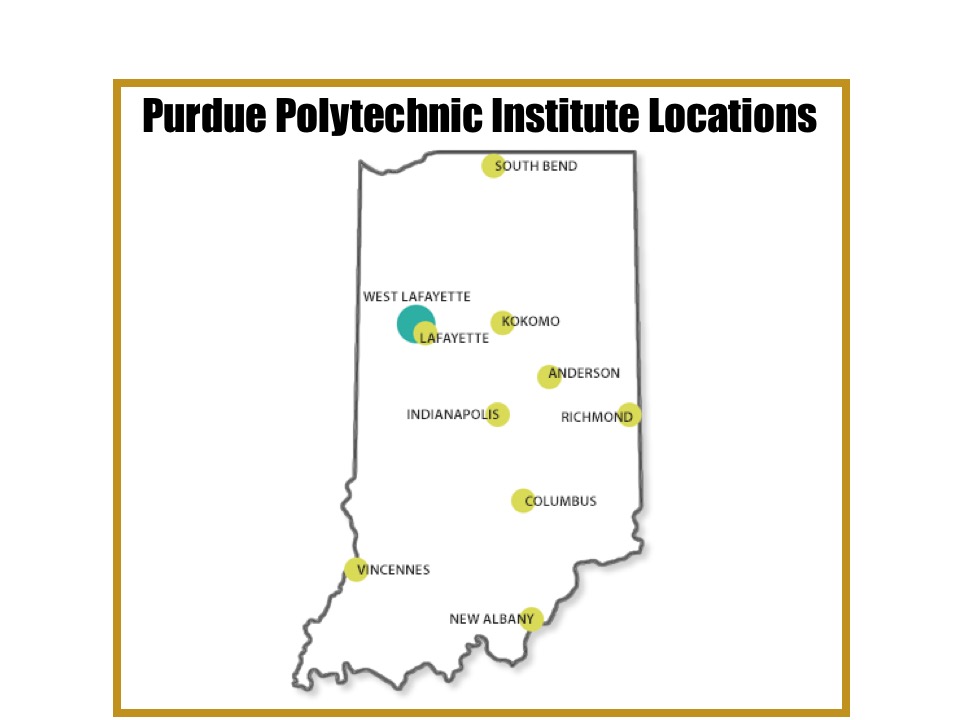 The assignment we have given the school’s leaders is a daunting one: to take 14-year-old students, many of whom are sure to be somewhat behind a college-preparatory schedule, and graduate them four years later qualified for admission to Purdue. Even with all the volunteer tutors, industry involvement, and financial contributions we can muster, this is a high-risk undertaking by any measure. It’s nothing our university, or perhaps any university, has ever done before. But we feel we must try.
The assignment we have given the school’s leaders is a daunting one: to take 14-year-old students, many of whom are sure to be somewhat behind a college-preparatory schedule, and graduate them four years later qualified for admission to Purdue. Even with all the volunteer tutors, industry involvement, and financial contributions we can muster, this is a high-risk undertaking by any measure. It’s nothing our university, or perhaps any university, has ever done before. But we feel we must try.
And if we succeed, consider the possibilities. The Polytechnic Institute already has 10 technology centers in operation around the state. If our people can make the Indianapolis high school work, each of these could one day be the site of another high school. Imagine a network of such schools, each tailored to the needs of low-income students and to the requirements of today’s economy, creating a pipeline of opportunity for hundreds of future Boilermakers who otherwise would never make it to Purdue. That’s a big risk, but one well worth running.
With all the dangers, or maybe because of them, it’s an exhilarating time to be at Purdue, and in higher education generally. American colleges and universities remain the best in the world, and indispensable assets for a nation that wishes to maintain leadership in today’s knowledge-based world. If new approaches are required to preserve and expand their viability, then by all means let’s identify and pursue them. Perhaps Purdue, true to its tradition of putting thought into action, can even lead in implementing them.
Change is rarely risk-free, but who better to analyze and calculate those risks than Boilermakers! In hopes that we are calculating wisely, and that my friend Gen. Doolittle would approve, I wish you a great 2017.
Hail Purdue!
![]()
Mitchell E. Daniels, Jr.
President
[i] Public Agenda. "Public Opinion on Higher Education." Public Opinion on Higher Education. 12 Sept. 2016.
[iii] Public Agenda. 2016.
[iv] Columbia Daily Tribune. "Other Missouri Universities Gain Enrollment as MU Numbers Drop." 27 Aug. 2016
[v] Class Central. “By the Numbers: MOOCs in 2016.” 25 Dec. 2016.
[vi] Babcock, Phillip, and Mindy Marks. “Leisure College, USA The Decline in Student Study Time.” American Enterprise Institute., 5 Aug. 2010
[vii] Rojstaczer, Stuart. Gradeinflation.com. 2016.